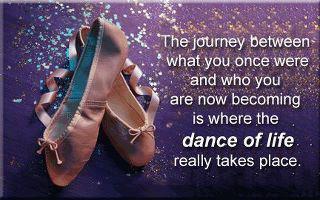My mission is to advocate for women as they attempt to dance with everything in their lives. Lives that these days seem to involve rapid and unrelenting change. There’s the fullness of life’s blessings, with children and grandchildren, and the challenges of learning and earning at school and work.
Then uninvited circumstances and challenges arrive that must be woven creatively into the lives we’d planned: caring for family members, grappling with ever new versions of technology, grieving the loss of loved ones and prior roles, financial and work challenges that impact health and well-being.
Margaret Mead warned we would need “to make our nest in the eye of the storm,” but dance with it all? Is that even possible?
What makes a dance?
Dancing is not just executing steps, or groups of steps to music, though that may be involved. The key to what makes dance out of a cluster of movements is the transitions between the steps.
When I was a professional dancer, I was often a choreographer’s assistant. My job was to work with the dancers, helping to translate the vision of the choreographer into the bodies of those who would be performing the work. As you are choreographing your life and focusing on the individual steps, you might welcome an assistant to help iron out the details of how you get from one step or phrase to the next. In other words, the transitions.
Graceful transitions will make your life challenges feel like a dance, and that’s where I came in. As your assistant and trusted advisor I might suggest, “After this phrase, let’s add one more step to get on the right foot. Otherwise you won’t be able to get there from here.”
“Do the dance that you’ve been shown,” James Brown suggests in his song, The Dancer, “until the dance becomes your own.” I’ve been teaching people self-care strategies for making the dance their own for over twenty years and one of my favorites is something I call “dialing down.” This technique is especially useful when times seem tough and life feels full of unrelenting stress. Dialing down doesn’t mean just “going-through-the-motions” or “marking” the steps. When you dial down, you challenge yourself to stay in the dance while using as little energy as possible. This becomes an exploration of efficiency and letting go of anything that is not essential. I have practiced this when I haven’t had enough sleep due to traveling and when I was a caregiver for one of my ailing children. The resulting gift, in life as in the dance is, once you have taken out the extras, you will feel yourself part of a graceful flow.
When we’re dancing, the struggle is gone.
But while in the learning phase, the steps feel foreign and awkward, so how do we get there? The process of learning new steps and putting them together in unique ways can seem a struggle. (It’s those tricky transitions again.) You may get the arm movements immediately or pick up the foot patterns, but it takes practice and much repetition to bring all the parts together.
A number of years ago, I visited a village in Malawi, Africa. Since I didn’t speak the language, I tried to learn the women’s dances by watching from the sidelines. Eventually, I moved closer, copying the movements from behind the women as they danced. But when one of the women pulled me close beside her in between herself and another woman while they danced, I caught on immediately. This reminded me that often in my life just standing on the sidelines didn’t get me where I was trying to go. Most dances and many other skills are learned best by doing them with others. So I advise women to surround themselves with other women who know what they need to know, and who live the way they want to live so they may flow and grow with ease, into a new reality.
Did you know that your body can know something that you don’t consciously know? I learned about this part of me that is “smarter than I am” when, several years after I’d left a contemporary dance company, the choreographer asked me to help her reconstruct a dance. The 18 minute piece had fallen out of the company repertory and current members hadn’t learned it. The choreographer didn’t remember much since she hadn’t performed it frequently for six years as I had, and she had created many other dances in the meantime.
As we engaged in a process to reconstruct the dance we realized that my body was the archive. Although I couldn’t remember much consciously, as we played the music and I began moving, my body remembered. On a kind of auto-pilot, getting a bit further with each repetition, my body was able to re-create the dance through its “muscle memory.” This amazing, seemingly magical skill taught me the importance of our body’s wisdom and of doing something often enough, and with enough fullness and awareness, to get it into your body. Once that happens, it belongs to you.
I began to apply these principles to my life outside of dance. Like children sing in the Hokey Pokey, “Put your whole self in, take your whole self out.” Then you can rely on the wisdom of your body to enable you to dance with everything. And when life is a dance, we’re not alone. There are many other people dancing with us. The steps may still be complicated, the phrases demanding. But once we’ve surrendered to become one with it, once we’re in the flow, the zone – it’s a dance.

